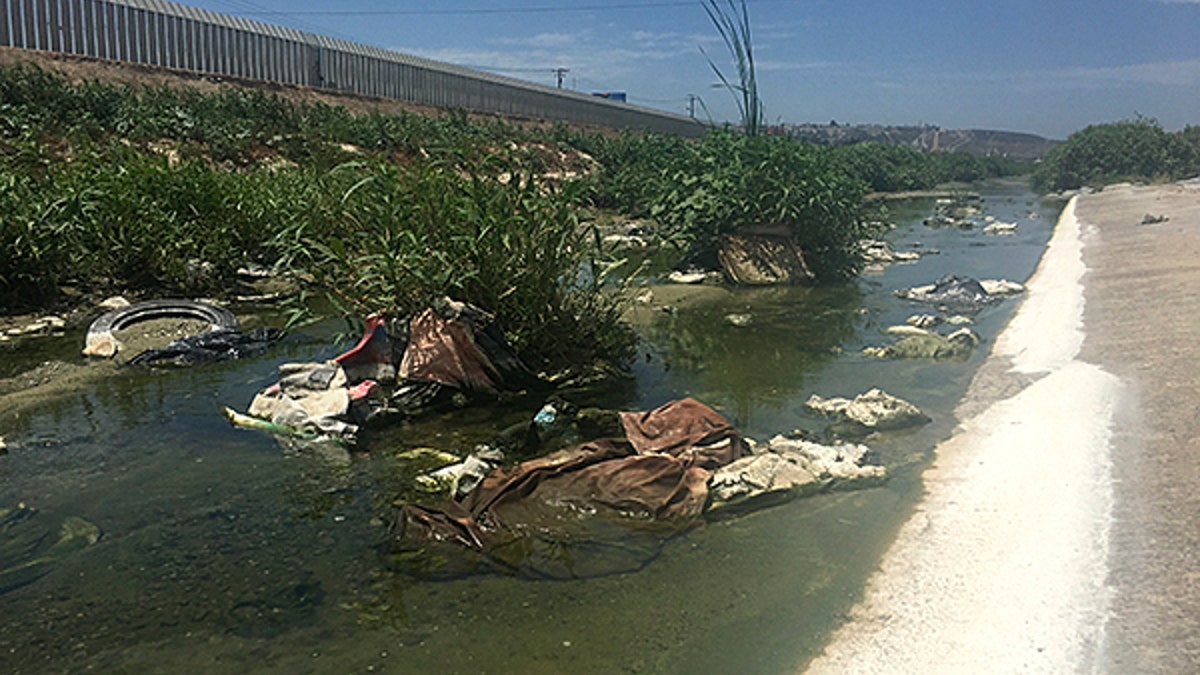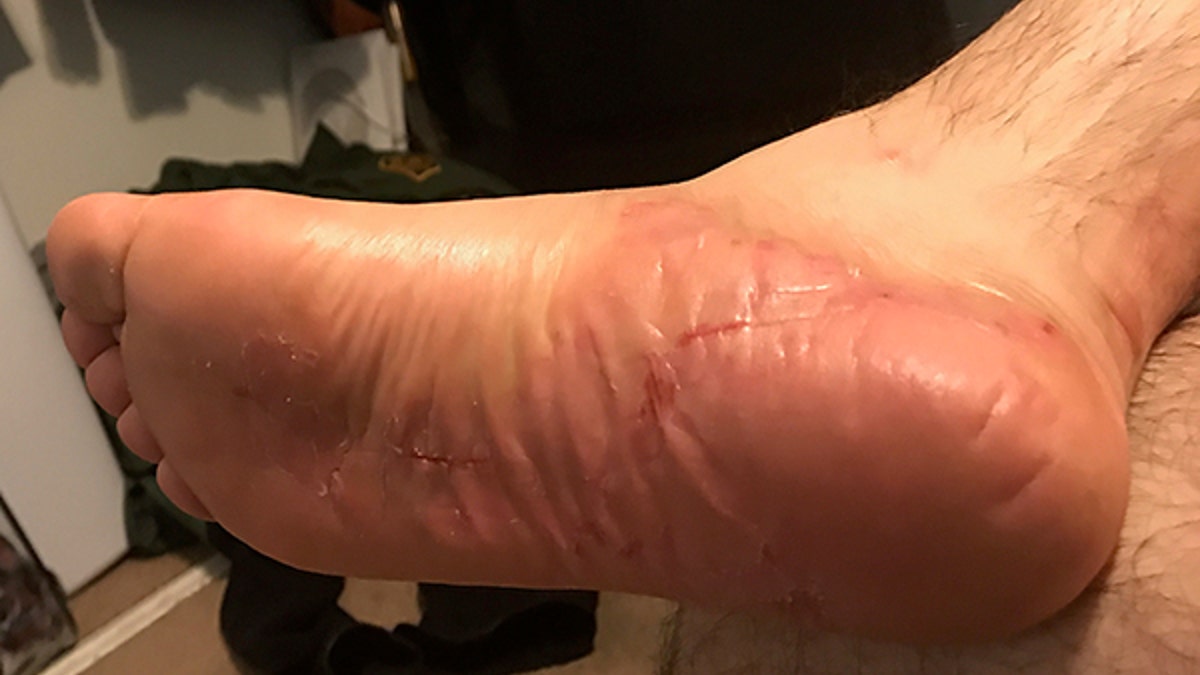
The Tijuana River, polluted with raw sewage, debris, and toxic waste and chemicals, flows into the ocean.
Millions of gallons of toxic chemicals and raw sewage are being dumped by Mexico into the Tijuana River, surrounding valleys and U.S. beaches at the U.S.-Mexico border, sickening border patrol agents, but those on the front lines say the U.S. has done little to force Mexico to literally clean up its act.
Some 59 Border Patrol agents have reported getting sick in the last three months after exposure to pollutants while at work along the border. One agent suffered severe chemical burns on his feet after toxic chemicals burned through his boots, according to documentation provided by the U.S. Border Patrol Local 1613 Union.
That union is threatening legal action that could result in all 300 people stationed at the Imperial Beach Border Patrol station to abandon their posts along the vast border between San Diego and Mexico. Border Patrol union leaders blame U.S. government agencies, Congress and the International Boundary and Water Commission for not aggressively addressing the continuing environmental pollution and health hazards. The organization is an independent U.S. commission directed by the State Department that oversees management of the river.
Because it oversees sanitation, water quality and flood control in the border region, the IBWC has become the focus of outrage by local government officials as well as the Border Patrol.
“It is going to get the point where they cannot patrol down there. That is a national security issue,” said Christopher Harris, secretary for the U.S. Border Patrol Local 1613 Union, which represents represent almost 2,000 US Border Patrol Bargaining Unit Employees in the San Diego Sector.

A US Border Patrol agent suffered chemical burns through his boots and uniform after he chased down a fugitive in the Tijuana Valley area.
“If a judge rules that our agents cannot work in that area, we are going to cede this back to no man’s land,” Harris warned, noting that this would leave a vast area of the border open to Mexican cartel smuggling fugitives putting local residents at risk.
During a tour of the U.S.-Mexican border arranged by the union, Joel Sevilla, a U.S. Army veteran who has been a Border Patrol Agent for nine years, told Fox News that last week he had to halt his ATV patrols.
“I like doing what I do, but now it has come to a point that every night I have headaches and every day I have headaches and nasal pain and I had to stop,” Sevilla said.
Numerous agents have suffered from gas inhalation, chemical burns, lung damage and infections, said Terrance Shiggs, president of the National Board Patrol Council Local 1613.
Serge Dedina, mayor of the City of Imperial Beach, one of the beachfront communities most impacted by the pollution, said that between 30 and 40 million gallons of sewage are discharged daily onto the beach from Mexico’s Punta Banderas sewage treatment plant six miles south of the border, and during south swells and south winds, the sewage washes up on U.S. beaches. Mexican sewage also flows into the U.S. from the Tijuana River. When there is a power outage affecting the sewage plant in Mexico, it is not uncommon for raw sewage to be discharged on to the U.S. side of the border, Dedina said.
The City of Imperial Beach is planning its own legal action over Clean Water Act violations, Dedina added.
“We can no longer tolerate our own government allowing this to happen,” he said.
Dedina said residents, small business owners, and Border Agents are frustrated that the International Boundary and Water Commission doesn’t take aggressive and immediate action to keep Mexican sewage and toxic chemicals from flowing into ocean, area canyons, the Tijuana River and a protected estuary.

The Mexican Cartel uses this vent, which toxic waste and sewage passes through, to traffic drugs and humans to the US from Mexico.
“We want to make sure our residents and the Border Patrol agents … and United States Navy SEALs who live and train in our city and just North of Coronado are not harmed by this mess,” Dedina said.
Dedina said the Department of Homeland Security should include new protections in the $200 million Congress just allocated for San Diego border wall upgrades.
The trouble with Mexico’s broken sewage system came to the forefront in February, when 250 million gallons of raw sewage poured from Mexico into the Tijuana River and then into the ocean for 17 days after the City of Tijuana’s sanitation system broke down.
No Mexican official disclosed the hazard, but the 200,000 people living in South San Diego, Imperial Beach and Chula Vista could smell the eye-watering, throat-burning smell of raw sewage from a mile away. The spill was the worst in the region in a decade, and resulted in several miles of beaches being closed for six weeks. Initially, the Mexican government pledged to fix the problem, but that changed.

Imperial Beach Mayor Serge Dedina holds a press conference to announce the city plans legal action to stop the raw sewage and toxic chemicals from coming over the border from Mexico.
“We were told on Aug. 4 by highest level American officials that the Mexican federal government has abandoned its effort to support this issue,” Dedina said. “The U.S. government has to step up and help us stop this toxic waste and toxic sewage from coming across the border.”
“I don’t think Mexico is doing this on purpose, but do I think they care - not a bit. The U-S government has to start doing some things to make Mexico care about its actions,” said Harris. “The U-S cannot solve this all alone, but we can mitigate the environmental hazards, and that is going to take the EPA and the International Boundary and Water Commission to get off the dime and start doing what they are supposed to.”
However, a spokesperson for the IBWC said the commission is taking a number of actions.
The commission is now investing $17 million into upgrading its $239.4 million sewage treatment plant built in the 1990s. Working groups have made recommendations to improve the area and some key studies are planned or ongoing. The commission established a bi-national spill notification protocol and plans new joint inspections every other month at key sites to monitor trans-boundary flows, said IBWC spokesperson Sally Spener.
"It is clear that when you look at the activities of the commission, not just since the February spill, but prior to that, there has been a long term interest and significant financial investment in improving the TJ river valley,” Spener said.
Dedina and others say the commission and federal government must take quicker and stronger action to stop the almost daily flows of raw sewage and toxic chemicals into the Imperial Beach and San Diego communities. More than 670,000 gallons of raw sewage are currently festering on Imperial Beach, attracting flies and mosquitoes, Dedina said.
“Somewhere along the way, the U.S. government has apparently decided that nothing needs to be done. That is unacceptable,” Dedina said. “This is not rocket science. … It requires funding, engineering and political will.”

